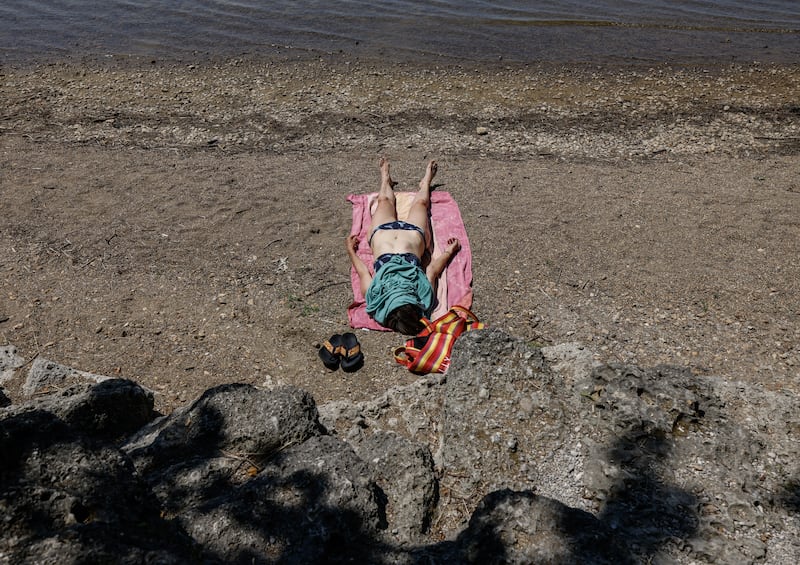A cool Ireland was on the right side of an oppressive “heat dome” this week, while tennis fans in Wimbledon were at its edge, enduring the hottest opening days on record, with temperatures of more than 34 degrees. Players resorted to ice packs on heads and fans attempted to create shade with hats, umbrellas, towels and clothing. Tournament stewards used “shade mapping” to guide spectators to cooler areas.
Just across the English Channel and closer to its core, it was a different cauldron, with oven-like temperatures. Much of continental Europe from northern Germany to the Mediterranean experienced 40 degrees plus. Heat maps were a blanket of red.

The heat dome phenomenon had returned with vengeance and earlier in the summer than before; enough to make unsurprised climate scientists consider whether this was yet another manifestation of our increasingly destabilised climate. It resulted in an area of high-pressure air becoming stuck over Europe. Atmospheric dynamics around it, in the jet stream enveloping Earth, blocked it from moving with low-pressure systems on either side. It was the meteorological equivalent of putting a lid on a boiling pot.
In the heat dome scenario, hot air heats up and compresses to form a “dome”. This intensifies heat and prevents cloud formation, allowing even more radiation from the sun to hit the ground below. Amplification of those atmospheric waves not only drives heatwaves but is also associated with wildfires and flash floods.
A “dual heat dome” is the simultaneous occurrence of two distinct dome events, as happened in Europe and North America in recent weeks, transforming much of the northern hemisphere into a sweltering hothouse. There is evidence to suggest this scenario is becoming more common and more intense.
Natural weather can be varied and unpredictable, but Met Éireann professor of data science for climate and weather at UCD, Andrew Parnell, says “extremely warm” weather is becoming more normal. Critically, the balance is being tipped from “unusual” towards “way too hot”.
And Ireland should not fall into the trap of believing it’s “over there”, a phenomenon affecting only sun holidays locations. “We are seeing this [warming trend] in Ireland if you look at temperature data,” he says.

There is no physical reason why a dome will not sit on this country at some point. Only luck on this occasion meant it was parked on mainland Europe, from where it moved slowly east. We might not be so lucky next time.
[ Ireland experiences fourth hottest June on recordOpens in new window ]
The severity of temperatures and the early timing of the current heatwave tally with how climate change is known to affect heatwaves. We don’t need yet more attribution studies to state this. As a result of human-induced climate change, heat is becoming more frequent and intense, and many scientists predict this “silent killer” will become the most challenging aspect of accelerating global warming.
Europe is already 2 degrees warmer than pre-industrial times and warming about twice as fast as the global average. This is due to its latitude; its many “concrete cities” and warming ocean currents, Parnell notes. Global average increases of 0.1 degrees disguise temperature jumps occurring at particular locations across the planet.
Europe – and this includes Ireland – is vulnerable due to a combination of factors: extremely warm seas off the northwest Atlantic, record levels of greenhouse gases in the atmosphere and unrelenting burning of fossil fuels causing carbon pollution that recognises no borders. The Mediterranean Sea is experiencing record highs, increasing the risk of Valencia-like autumnal storms.
We may not have to suffer the worst heat domes but Ireland will not avoid hotter summers and more prolonged droughts. Extreme flooding is probably the worst form of extreme weather event exacerbated by climate disruption facing us.
Parnell’s research is increasingly focused on lack of preparedness for the health effects of extreme weather, and from heat in particular, which goes “beyond obvious things like skin cancer”.
There is the heightened risk of many more cardiovascular strokes. Separately, prolonged heat can overwhelm the body’s ability to regulate temperature, leading to dehydration, heat exhaustion and potentially fatal heatstroke. Older people are especially vulnerable.

Mental health complications linked to sleep disruption are perhaps the least talked about health impact. Extreme heat can exacerbate existing symptoms of depression, anxiety and stress in addition to physical symptoms. All these factors can combine to overwhelm a health system.
Environmental threats are also likely to have cascading impacts on water availability, transport links and the usability of certain buildings.
Summer temperatures frequently exceeding 40 degrees are already a reality for southern Europe stretching from Spain to Turkey. This is undermining tourism, driving tourists to travel in offpeak seasons, much like the way the Middle East manages its tourism. It is forcing a rethink on large outdoor events. Working outside in daytime hours is becoming impossible. Agriculture is increasingly hampered, particularly growth of fruit and vegetables and wine production.
Parnell says Ireland needs to plan, beginning by putting in place robust early-warning systems, whether the threats are extreme floods or heatwaves, including setting out likely demands on health services. We will have to learn lessons from what has become necessary in Europe, including special shaded structures and cooling zones.
With surging heat-related “excess deaths” inevitable in coming decades, “at least Ireland has the opportunity to plan for that ... We know this is coming. We know exactly what’s going to happen. We can do a lot more on preparedness.”
Catastrophic consequences from a raging climate crisis are evident in many parts of Earth. Yet the human response this week seemed little more than complaining about searing heat. Undaunted, tourists in Crete swam in the sea as wildfires raged in the hills behind them. It coincided with countries gathered at a pre-Cop30 meeting yet again ducking their obligations. Some observers contend they are abandoning scaled-up ambition – an emergency response – and veering towards paralysis that will become obvious when they gather in Brazil next November.
Parnell fears it will take some horrible tragedy to provoke people and countries to respond adequately – the destruction of a large part of a country or huge loss of life: “It’s terrible to think this might be what forces us to do what we know we have to do.”














